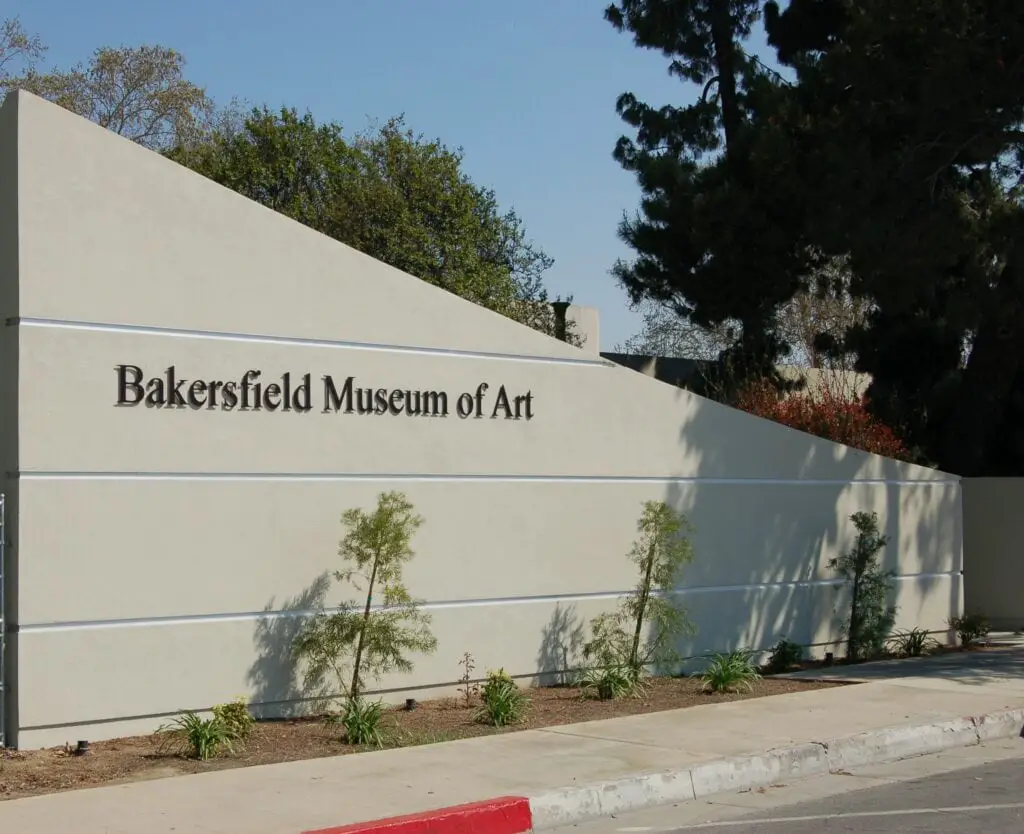Foundation and Early History
The Bakersfield Museum of Art opened in 1954, funded by the Walter Osborn family. They named it Cunningham Art Gallery in memory of Marion Osborn Cunningham.
Their initial donation and contributions from other benefactors allowed the construction in Central Park, Bakersfield.
The museum officially began operations in 1956. It was dedicated to showcasing local artists. Volunteers from the Bakersfield Art Association managed the exhibits, and the city-appointed Art Commission oversaw the museum’s operations.
The museum became a cultural hub on the corner of 19th St. and R St. It included gardens displaying sculptures and other art forms.
The museum provided a platform for regional artists and hosted occasional traveling exhibits, contributing to the list of things to do in Bakersfield, CA.
Transition to City Ownership
The city took over its maintenance when the museum finished construction in 1956. The Bakersfield Art Association volunteers ran day-to-day operations, and the city-appointed Art Commission managed it. This partnership allowed the museum to thrive and focus on local art.
The museum’s location at Central Park helped it become a key part of the downtown area. The gardens around the museum displayed sculptures and art forms, adding to the area’s cultural landscape.
During this period, the museum mainly showcased local artists and hosted occasional traveling art shows.
The city and local artists’ involvement created a vibrant community around the museum, contributing to Bakersfield’s cultural identity.
Expansion and Renaming
1990, the museum changed hands from the city to the Bakersfield Art Foundation, marking a new chapter.
They renamed it the Bakersfield Museum of Art. A year later, the American Alliance of Museums accredited it in 1991.
In 1997, the Patricia Crail Brown Foundation and Dr. George and Millie Ablin made endowments. These funds launched a campaign to expand the museum.
Later that year, the foundation purchased the land from the city, giving the museum a firm base for growth.
The expansion project began immediately. By 2001, the museum had grown to 17,400 square feet. The new space included larger galleries, classrooms, and a banquet hall, enhancing its ability to serve the community and host various events and exhibits.

New Facilities and Exhibitions
By 2001, the Bakersfield Museum of Art had expanded to 17,400 square feet, which allowed for more extensive exhibits and educational programs.
The museum now housed two large and two smaller galleries, providing space for permanent collections and traveling exhibits.
The museum added two classrooms and a banquet hall. The classrooms supported educational programs for both children and adults.
The banquet hall became a venue for various events, from art lectures to community gatherings. This expansion helped the museum become a central part of the community.
Outside, the gardens featured various sculptures and art forms. These outdoor exhibits offered a different experience from the indoor galleries.
They enhanced the museum’s appeal and provided a serene environment for visitors. The gardens were crucial in making the museum a versatile cultural destination.
Permanent Collection and Temporary Exhibits
The Bakersfield Museum of Art focuses on art from regional artists. Its permanent collection highlights the talent and creativity of artists from the area.
This focus on local art helps support and promote Bakersfield’s cultural heritage and the surrounding regions.
The museum regularly hosts traveling exhibits. These temporary shows bring diverse art from around the world to Bakersfield.
They offer visitors the chance to see various styles and mediums. These exhibits keep the museum dynamic and engaging, attracting locals and tourists.
The museum’s strong permanent collection and varied temporary exhibits ensure that it offers something for everyone.
It supports local artists while exposing the community to global art trends, making it a vital part of Bakersfield’s cultural scene.
Community Engagement and Educational Programs
The Bakersfield Museum of Art invests in the community through various educational programs. These programs cater to children and adults, offering classes, workshops, and lectures.
In 2003, the museum started an annual summer art camp for kids, providing a creative outlet during the school break. Local schools frequently collaborate with the museum, integrating its resources into their curriculums.
In 2005, the museum introduced an outreach program targeting underprivileged neighborhoods. This initiative brings art education to those who might not otherwise have access.
Mobile art workshops and traveling exhibits visit community centers and schools, expanding the museum’s reach beyond its physical location.
Special events, like the annual Bakersfield Art Fest, held since 2008, draw crowds from all over the city. These events include live demonstrations, artist talks, and interactive exhibits.
The museum also partners with local businesses and sponsors to fund and promote these events, ensuring they remain accessible to everyone.
Bakersfield Museum of Art Today
Today, the Bakersfield Museum of Art is a cornerstone of the local cultural scene. It continues to host a range of exhibits, from regional art to international collections. The museum adapts to contemporary trends while preserving its core mission of celebrating local talent.
The museum collaborates with various organizations, including the Bakersfield Symphony Orchestra and the Kern County Historical Society.
These partnerships create multidisciplinary events that attract diverse audiences. Art lovers, historians, and music enthusiasts find something interesting at the museum.
Technological advancements have also entered the museum. Since 2015, interactive digital exhibits and virtual tours have been available on the museum’s website.
These features allow those who cannot visit in person to experience the art remotely. The museum remains a dynamic and evolving institution, continually finding new ways to engage with the community and art lovers worldwide.
